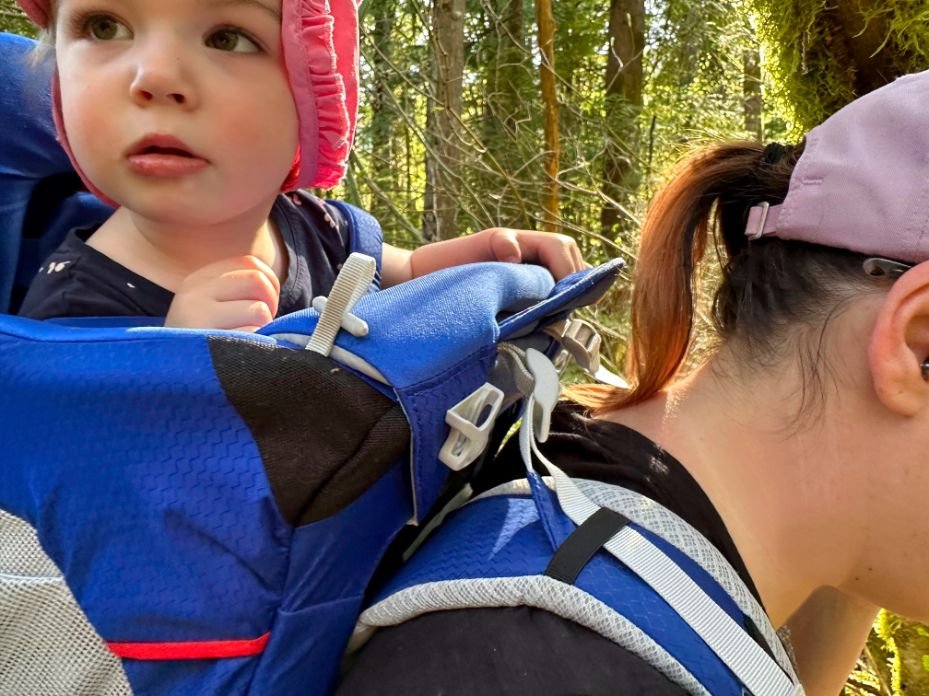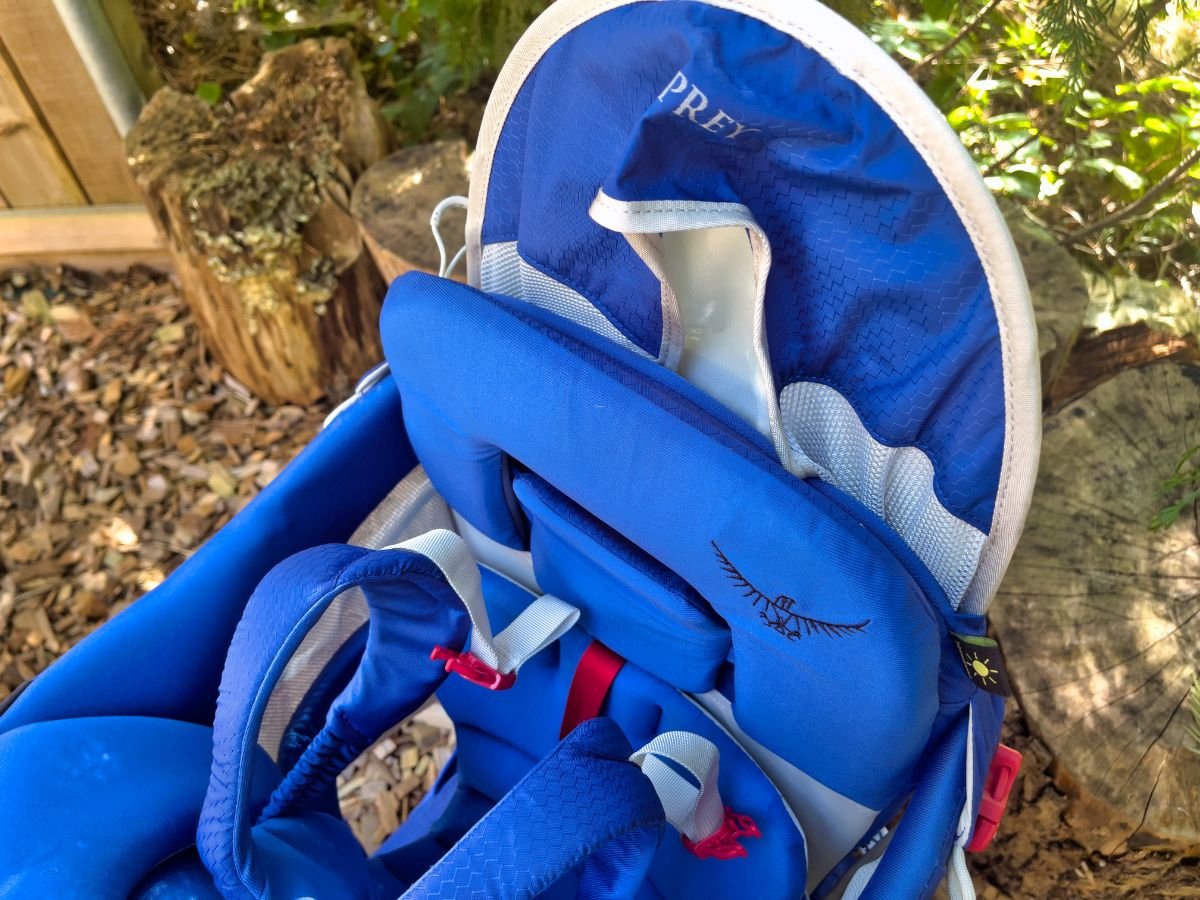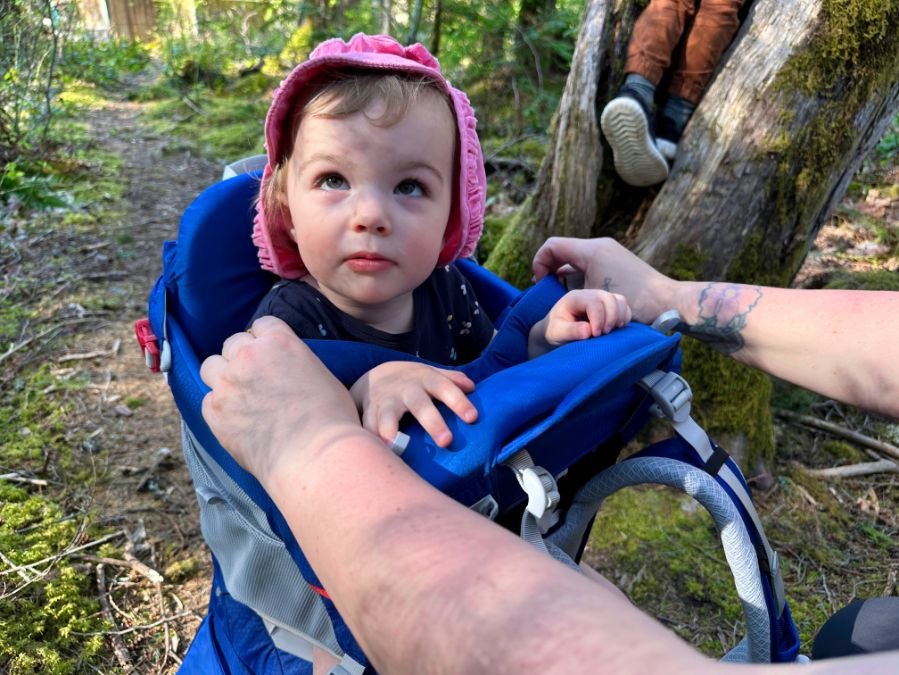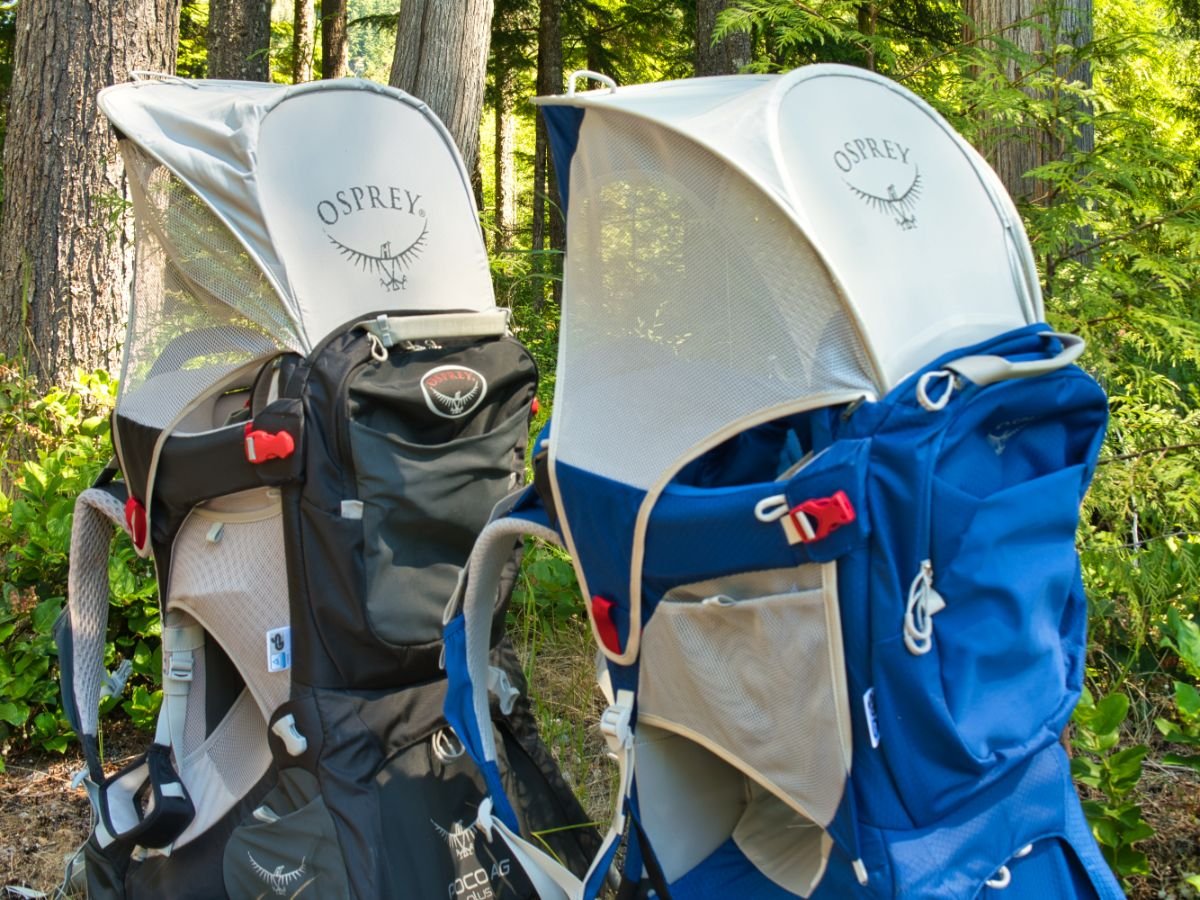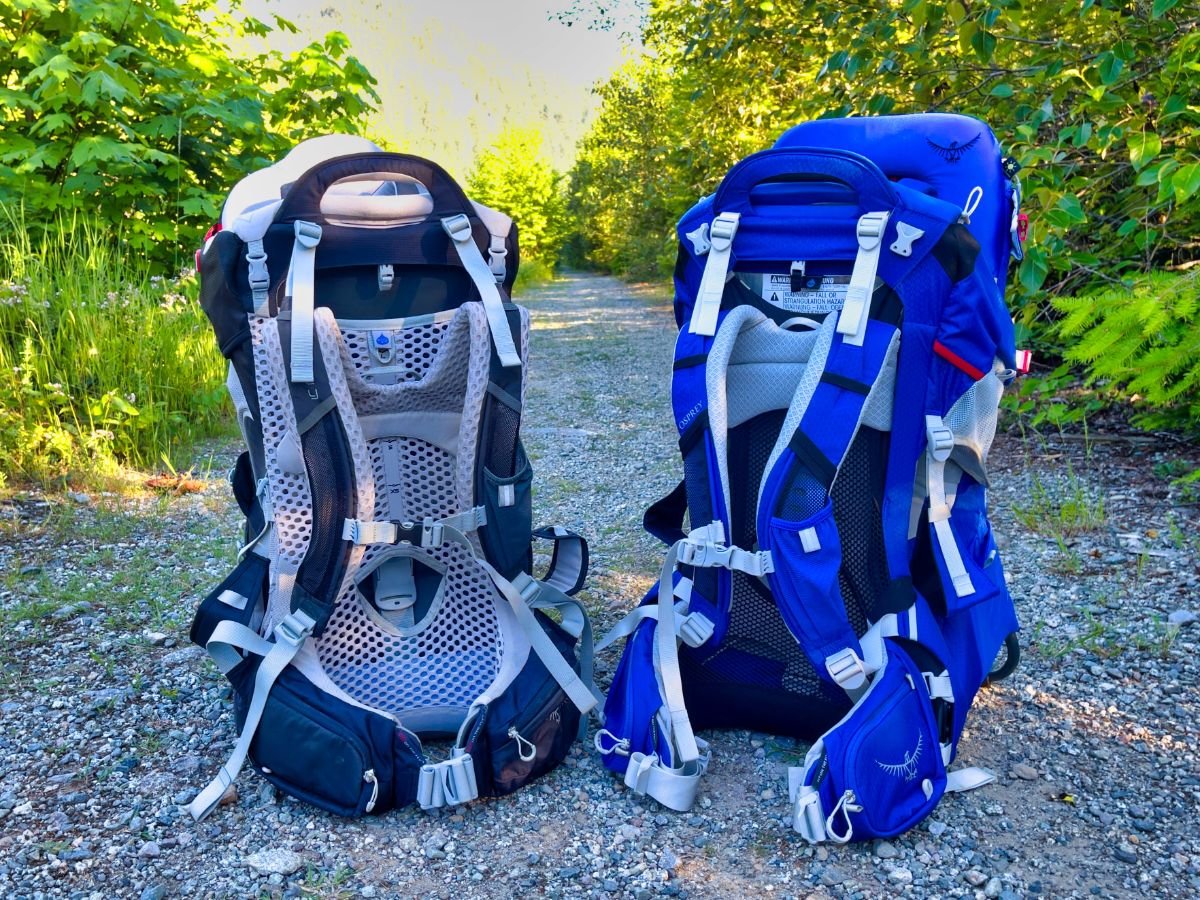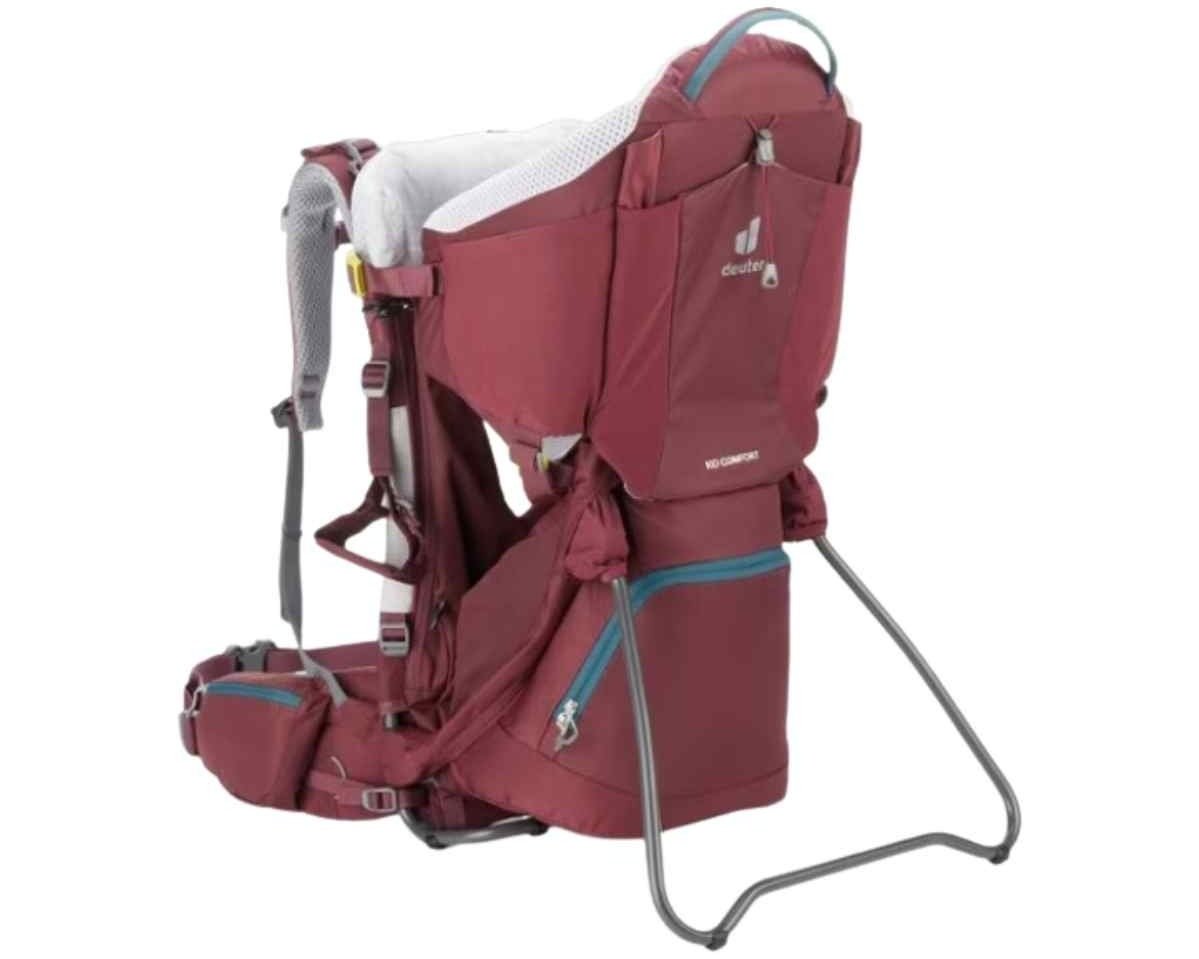Osprey Poco Plus Child Hiking Carrier Long-Term Gear Review
Supreme comfort, diverse features, and structured child cockpit make this our favorite backpack for carrying babies and toddlers
April 25th, 2025 to include notes about where to still find it and other similar baby carriers
Home > Gear Reviews > Hiking
Note: the Osprey Poco Plus Child Carrier has been discontinued, but may still be available at some retailers.
The Osprey Poco Plus Child Carrier is the Cadillac of hiking carriers. It’s feature-heavy and quality-built to last through many kids and families. Comfortable for both child and adult, it has a padded, adjustable hipbelt and shoulder straps, adjustable torso length, a structured cockpit with a supportive seat, a 5-point safety harness, and an adjustable stirrup length. The biggest benefit, though, is that the Poco will grow with your baby and see them through their toddler years, so there’s no need to swap carriers or make additional investments.
This lightweight aluminum frame baby carrier features a removable and washable drool pad, built-in sunshade, hydration sleeve, and ample storage options for both the baby's gear and the parents' essentials, with a large main compartment and multiple pockets found all over. The Poco Plus also has excellent ventilation, with breathable mesh and large side vents to keep the parent and baby cool and comfortable on warm days.
After testing a handful of the best hiking carriers for babies and toddlers, I long-term tested the Poco Plus carrier against its predecessor (the Osprey Poco AG Plus) and top competitor (the Deuter Kid Comfort carrier).
Overall, the Osprey Poco Plus is a well-designed and reliable carrier that offers a comfortable, safe, and convenient way to hike with young children. In this Osprey Poco Plus Review, find out why it remains our top pick for best baby and child carrier.
Editor’s Note: The Osprey Poco Plus has been discontinued and updated to the Osprey Poco Premium. Read our in-depth review on the Osprey Poco Premium for more info on the differences. The Poco Plus is still available at some retailers with limited supply.
COMPARE PRICES OF THE OSPREY POCO PLUS CHILD HIKING CARRIER
We create reader-supported, objective gear reviews independently selected by our editors. This story may contain affiliate links, which help fund our website. When you click on the links to purchase gear, we may get a commission – without costing you an extra cent. Thank you for supporting our work and mission of outdoor coverage for every body! Learn more.
Osprey Poco Plus Specifications
Weight: 7 lbs 14.4 oz
Total weight capacity: 48 lbs
Storage capacity: 26 L
Dimensions: 26.75 x 29 x 15.7 inches
Sunshade: Yes, UPF 50
Rain cover: sold separately
MSRP: $320
Best for
The Osprey Poco Plus is best for people who want a comfortable and structured hiking carrier to safely carry their baby as they grow into a child from about six months to four years old, along with plenty of gear for a day of hiking.
The Osprey Poco AG pack flattened. The Osprey Poco AG pack folds up to a smaller, condensed size. Photo by Steve Redmond.
What We Like
The Poco Plus prioritizes child safety, with a five-point harness, safety buckles, and structured cockpit that keeps them secure during outings or even the occasional stumble.
It’s comfortable on the wearer’s hips, shoulders, and back, easy to adjust on-the-fly, and has a ton of storage for all the daily essentials that come with hiking with kids.
It also flattens and folds to a smaller, condensed size for convenient use while traveling to-and-from trailheads, new cities, or other destinations.
On the hunt for the best baby backpack carrier, we had adults of different sizes, weights, and shapes carry their child in the Osprey Poco Plus. Photo by Ebony Roberts.
How We Tested
Before I tested the Osprey Poco Plus, I hiked with the previous version for over two years, from when my son was first able to use it at around six months old to around two-and-a-half. My partner (6’) and I (5’4”) carried our son through all four seasons in varying conditions. From when my child was about three until about four, my partner and I hiked with the updated Poco Plus, as did friends and family who borrowed it frequently and reported on their experience.
The Poco Plus child carrier also saw many miles off-trail, too. Strollers can be cumbersome, especially on busy streets, and the baby carrier proved a good alternative. I took it out for city walks, festivals, and on vacations. Not only did I find it easier to maneuver than having a stroller in tow, but my son appreciated the higher vantage point and could better take in the sights around him.
All in all, both versions of the backpack carrier have seen hundreds of miles of use. We’ve also set both carriers side by side and poured over the details, noting any new changes.
The child harness on the Osprey Poco Plus is easier for parents to load and unload small children. Photo by Steve Redmond.
Technical Design Features
Set Up and Storage
The lightweight aluminum frame on the Osprey Poco Plus provides a stable platform to set the child carrier down. When loading the Poco Plus, the integrated kickstand is sturdy and easy to deploy (an audible click lets you know it's in place). Sidearms rotate and lock into place to create the rectangular cockpit. Once the child is loaded, two robust grab handles make donning the soft structured carrier manageable.
When storing, the side arms fold so the carrier can be laid (somewhat) flat. The Poco Plus still takes up a significant amount of space for a carrier, but the structured cockpit and safety features are worth the extra bulk.
The hipbelt on the Osprey has room for all the items you need for kids and animals you care for while on a hike. Photo by Steve Redmond.
Fit and Sizing
There are plenty of ways to dial in the fit of the Poco Plus so that adults and babies will be their most comfortable. For adults, adjustments can be made to the hipbelt, shoulder strap, and torso length.
The hipbelt range on the Poco series hiking carriers is 26"to 48", but the Poco Plus has a feature not found on other Poco models. The Poco Plus has fit-on-the-fly extender wings for quick on-trail adjustments to the padded belt. This feature provides a few extra inches on each side, allowing it to fit hips up to about 54 inches.
The hipbelt’s redesign is noticeably more comfortable on the new Poco Plus model than older versions of the same Osprey baby carrier because it’s more breathable, and the extender wings add additional padding.
Close up on the sternum strap and generous padding in the shoulder straps on the Osprey Poco Plus child carrier. Photo by Steve Redmond.
A cut-out in the mesh back panel allows you to reach the lever for torso length adjustment, which is easy to lift and slide. The chest strap on the shoulder harness also slides up and down for added adjustability.
Torso sizing ranges from 15 to 21 inches, measured from the bump at the base of your neck to your hip bone. My partner and I differ in height, so when we swap the carrier, everything needs to be re-fitted, which takes under a minute.
You can adjust the torso height on the Osprey Poco Plus carrier so that adults of different heights can share the fun of carrying the child. Photo by Steve Redmond.
The Osprey Poco Plus has a load range of 23.89 to 48.5 pounds for children. This minimum to maximum range combines the weight of the child, your gear, and the hiking carrier, so in reality, when your child is 40 pounds, they’ve hit the weight limit (about four years old).
To use the carrier, your baby must be able to sit upright unassisted and not weigh less than 16 pounds. In general, that’s around six months old. For kids, you can adjust both torso and stirrup lengths. The harness straps are stretchy, so they won’t need to adjust.
Hiking with a child inside. Notice the abundant pockets on the outside for easy access to snacks, diapers, or extra layers. Photo by Steve Redmond.
Weight
The Poco Plus weighs 7.89 pounds, which sounds like a considerable amount to have to heave up onto your back with a little one in it, but I found it to feel much lighter than expected when worn. The weight distribution of the pack, coupled with the ability to tweak the torso and hip lengths, significantly helps it not feel overly heavy.
Close-up on the cockpit area of the Osprey Poco Plus carrier (without a child inside). Photo by Ebony Roberts.
Gear Capacity, Organization, and Pockets
The Poco Plus has a storage capacity of 26 liters, broken down like this:
2 open mesh pockets on the side of the child cockpit
Small zippered stash pocket at the neck for small items
Lower 17-liter zippered compartment
Zippered back panel compartment with outer mesh sleeve
Lower mesh open-side pockets
2 zippered hipbelt pockets
Zippered hydration sleeve
The multi-pocketed configuration makes it easy to store and organize everything you’d need for a day out with your baby or small kid. When traveling with kids, either outdoor adventuring or on vacation, it’s helpful that everything has a home and that things stay compartmentalized.
This child carrier backpack easily fits diapers, wipes, a changing pad, extra clothes, water, snacks, and trail toys. (There are three extra clippable loops around the cockpit for toysthose!). We often found ourselves hiking to a lake for an afternoon picnic and packed small towels, swimwear, and a beach blanket along with all our other daily essentials.
Whether on even or uneven ground, the Osprey is comfortable for both the child and the one carrying the child. Photo by Ebony Roberts.
The kickstand must stay out when using the lower compartment to keep from squishing the contents, making the carrier slightly less maneuverable than the standard Poco or the Deuter Kid Comfort because there’s more of the carrier sitting away from your body. It’s a small price to pay for more storage space, though.
We appreciated the safety and robustness of the padded cockpit area of the Osprey Poco Plus child carrier. Photo by Steve Redmond.
Cockpit, Harness, and Child Seat Design
A fully framed and padded cockpit surrounds the adjustable Double Halo harness and child seat for safety. It’s robust, solid, and secure, and when carrying a baby, it felt the most protective of any carrier I’ve worn--like the closest thing to a car seat of any carrier I’ve worn. The contact surfaces, like the drool pad, are soft, and the ventilated side panels provide comfort for hot days. The front pad can be removed for washing, and although it takes practice to remove and reinstall it correctly, washing it is key.
The reworked design of the child cockpit and harness on the Poco Plus makes it stand out most among other carriers. Like many child carrying backpacks, the harness on the older version of the Poco buckled in front. The new model has shifted the buckle to the child’s back, making it easier to get them into the harness. The shifted buckle makes for a more comfortable ride, too.
The straps have some stretch and can secure to clips on the front of the pack to keep them out of the way while loading your child. Adjusting the seat height is easy by lifting the marked red handle and pushing the seat down to the desired length; just slide the handle back up to lift it up. If you’re swapping kids out on the trail, it makes adjusting the seat fast and easy.
We tackled rough and rocky trails in the Osprey Poco Plus child carrier and found it to be comfortable even as a child grows. Photo by Steve Redmond.
Essential Criteria
Carrying Comfort: Stability and Maneuverability
Given the feature-loaded and robust safety design of the Poco Plus, it’s no surprise that it can feel less maneuverable than much lower-profile carriers. When fully loaded, it does feel large and can slightly pull backward or tip forward on steeper inclines and descents (an issue not felt on flat terrain), depending on the hike. Tightening the load lifter straps at the shoulders helps immensely with stability as it cinches the top of the carrier down closer to your body and keeps the top from swaying. You can also help eliminate any issues by ensuring the fit is correct because the shoulder straps and hipbelt affect how the pack stabilizes and wraps around the back and shoulders.
When my son was young, the safety of the big rectangular cockpit felt important, but it does come at the slight cost of maneuverability. My partner, who’s six inches taller than me and has a stronger core, didn’t find the side-to-side sway an issue. With practice, though, you get used to the movement of the pack and are better able to control it on an uneven trail. (The Deuter Kid Comfort carrier rotates at the hips, making it feel more agile with less side-to-side swing, so if you won’t be carrying babies, consider the less expensive Deuter carrier.)
Fit your carrier and its straps before you head out on your hike. Photo by Ebony Roberts.
Long-Term Durability: Build, Sewing Quality, and Abrasion-Resistance
When you have a child-carrying backpack with a lot of features and components (like pockets, zippers, pull tabs, belts, adjustable levers, kickstands, sunshades, harnesses, etc.) there’s a lot of potential failure points, but the Poco Plus is darn-near indestructible. With both Osprey hiking carriers I’ve tested (an older Poco and the newer Poco Plus), not a single stitch has come loose, a buckle cracked, or a zipper busted, and after long-term testing, it looks nearly new—it’s that well-built.
The harness system on the Osprey Poco Plus. Photo by Ebony Roberts.
Breathability and Ventilation
The older model of the Poco hiking carrier was already plenty breathable, but the new version takes the breathability up a notch. It’s one of the best things about the carrier. Unlike frameless carriers with your child pressed against your body, the structured child’s cockpit sits off your back, so it’s already less hot to hike in. Plus, similar to an Osprey backpack for backpacking, mesh paneling on the back panel of the carrier adds airflow without compromising comfort or mobility. The shoulder straps and hip belt have been redesigned with additional mesh and cut-out vents that feel more comfortable to hike in than the previous model.
The child’s cockpit also features mesh along both sides for airflow, and even with all the soft cushy fabric, no child that rode in our carrier has ever complained about being hot, even in mid-summer temps.
Water Resistance
I live in the Pacific Northwest, so the Poco carrier has seen its fair share of rain. Water beads off the fabric well enough, and the sunshade does a decent enough job of keeping a drizzle at bay, but if you plan to hike in the rain for extended periods, Osprey makes a compatible rain cover that you can purchase separately.
The sun shade on the Osprey Poco Plus is the best we’ve seen on any child carrier. Photo by Steve Redmond
Sun Protection
The Poco Plus boasts a cleverly designed built-in sunshade, easily deployed from the zippered stow pocket behind the child's head. The sunshade slides out of the pocket, and two red tabs hook onto the corresponding sleeves near the wearer’s shoulders.
The added mesh on the sides not only enhances the little one's shaded experience but also provides an extra layer of protection against harmful UV rays. Unlike other carriers that lack this essential feature, which can leave children susceptible to the sun's harsh glare, the Osprey sunshade eliminates this problem, ensuring child comfort and a safe ride for your little adventurer. The sunshade provides UPF 50 sun protection. However, because children’s skin is thinner than adults, we still recommend using a kid-appropriate face sunscreen and body sunscreen for any time spent outside of the carrier.
Close-up on the kickstand feature on the Osprey Poco Plus. This is one feature that makes it easy to use not just on hiking trails, but also on trips to the farmers market, strolling city streets, and vacations. Photo by Steve Redmond.
Versatility
As someone who loathed stroller life, I found the Poco Plus to be highly versatile as I’d use it for carrying my child on hiking trails, trips to the farmers market, strolling city streets, vacations, and just about anywhere I could to avoid pushing a stroller. There are more low-profile carriers to haul babies and toddlers around that aren’t as heavy and bulky, but for trail use, I appreciate the added safety that the Poco Plus’s structured cockpit provides.
Value
The Poco Plus retails for $320, making it one the most expensive hiking carriers you can purchase. However, that price is down from $395 in 2023, making it one of very few gear items we review that has had a price reduction. Now, it is the same price as the Deuter Kid Comfort.
If you’re an avid hiker, the cost per use is likely worth it for the safety and comfort it provides. Given the pack’s durability and quality build, it will hold up well through multiple children. If you only expect to get out a handful of times on the trail with your little one, there are certainly comfortable options that are safe and cost less (like those below).
However, I live in a mountain town and frequently see this carrier listed on secondhand marketplaces, and they’re always scooped up fast, so you can bet you’ll make some of your money back if you choose to resell.
You can learn more about buying and selling on used gear markets in our guide to All About Used Gear.
Sustainability and Ethical Manufacturing
Osprey has been a Bluesign system partner for 3 years, and it’s one measure they’re taking to boost their sustainability efforts. Bluesign is a Swiss-based independent authority that works with suppliers, textile manufacturers, and brands to ensure that materials and chemicals used in manufacturing are free from substances and processes harmful to the planet.
There are different Bluesign stamps of approval; sometimes, a whole product will be certified, and other times certain components will come verified. In the Poco Plus, the main fabric—a strong and flexible ripstop nylon—is Bluesign approved, meaning that it’s made with approved chemical products and raw materials that have met strict safety and environmental requirements designed to reduce the impact on people and the environment.
Warranty and Repairs
The Poco Plus hiking carrier comes with Osprey’s 7-Year All Mighty Guarantee (some Osprey products have a lifetime guarantee, but the hiking carrier’s is limited to seven years). Osprey will repair any damage or defect for any reason free of charge during the first seven years from the date of manufacture. If they cannot perform a functional repair on your Poco Child Carrier or Poco Accessory, they state that they will “happily replace it.”
Our one critique of the Poco Plus is the stirrups foot hole doesn’t always work for big kid shoes. Photo by Steve Redmond.
What could be better
There’s not a lot to critique about the Poco Plus, but the stirrups are a point of frustration. They’re adjustable length-wise, but the foot hole is one-size-fits-all, which unfortunately doesn’t fit all. It’s hard to get big kid boots in and out. Slim-fitting hiking shoes aren’t an issue, but a three-year-old in rain boots is a struggle. When you’re taking your bigger kid out of the carrier, they’re sure to lose a shoe when pulling their feet out of the stirrups.
For some people, especially those under 5’5”, the large grab handle at the back of the neck can be irritating. Because the pack tips slightly forward, you may feel the handle rubbing on the back of the neck when you look up-trail. For long uphill hikes, it will be noticeable. Fortunately, you can tuck away the grab handle under the drool pad, but you’ll need to redeploy it before removing the pack.
Comparison of the Osprey Poco (left) and Osprey Poco Plus (right). Photo by Steve Redmond.
What's the difference between the Osprey Poco and Osprey Poco Plus?
The main difference between the Poco and Poco Plus is the storage capacity. The standard Poco carrier can hold 20L of gear, while the Poco Plus holds 26L (that extra six liters is enough room to stash a couple extra puffy jackets, some rain gear, or a beach blanket and sand toys).
The Poco has open mesh pockets on the hip belt and a smaller lower compartment. In contrast, the Poco Plus has larger zippered hip belt pockets, additional lower mesh side pockets, and a larger lower zippered compartment—so overall, there are more places to organize and stash items. The Poco Plus also features an adjustable fit-on-the-fly hip belt that increases the fit range by five inches on each side (the standard hipbelt sizing is 26 inches to 48 inches).
This extra storage capacity and added hip belt feature is a 30 dollar upgrade. (the Poco costs $320; the Poco Plus costs $290). The price is worth it for some parents because it’s just enough added space to avoid carrying a second backpack for family-sized snacks and other essentials your whole crew might need.
Other than this difference, the two hiking carriers are essentially the same, with the same maximum load capacity of 48.5 pounds, roughly the same weight (just over 7.5 pounds), and nearly the same folded footprint, taking up the same storage space. All the kid-related features are the same, too.
Related: read our full review of the Osprey Poco SLT child carrier.
Where to buy
The Osprey Poco Plus Child Carrier are popular gear items, so you have options when it comes to retailers. Here are some of the pros of the retailers.
Scheel’s
Pros: American privately held, employee-owned and operated store
Amazon
Pros: Free shipping with Prime members.
Other Child Carrier Backpacks to Consider
When deciding between the Osprey Poco Plus and other child carriers, consider the most important features. These packs are comfortable carriers that can withstand many years of use, seeing your child through the baby phase and well into their toddler years. See our full child carrier review piece for more options.
Deuter Kid Comfort
Weight: 7 lbs 2 oz
Weight capacity: 48.5 lbs
Storage capacity: 14 L
Dimensions: 28 x 17 x 13 inches
Sunshade: Yes
MSRP: $320
The Deuter Kid Comfort is a well-constructed, comfortable, easy-to-use, full-featured hiking carrier that closely rivals the Osprey Poco Plus.
The Osprey pack felt more secure for babies, but as kids grow, the Deuter Kid Comfort edged out the Poco in maneuverability because it pivots at the hips better, making it more agile to wear. It has less storage capacity, but it’s well-ventilated, adjustable for kids and adults, and has a built-in sunshade.
Although last year, the Deuter Kid Comfort was less expensive than the Osprey Poco Plus, they are now the same price. Ultimately, we recommend both packs and think they serve different purposes, depending on the size of your child.
Read our in-depth review of Deuter Kid Comfort.
Editor’s Note: As of May 8, 2025, Deuter recalls the Kid Comfort. Please read more from the Consumer Protection Agency to see if your model was impacted.
COMPARE PRICES OF THE DEUTER KID COMFORT
Kelty Journey PerfectFIT
Weight: 6 lbs 6 oz
Weight capacity: 48.5 pounds
Storage capacity: 17 L
Dimensions: 28 x 20 x 15.5
MSRP: $270
The Kelty Journey PerfectFIT has everything you need in a reliable child carrier for $270. If you don’t plan to hike often or for long days, it’s an option worth considering. Still, it doesn’t have as good of ventilation or adjustability as the Poco Plus, and it’s not hydration pack compatible, nor does it come with a built-in sunshade (but you can purchase one separately). One gear review on REI noted that they have a hard time loading in big kids and that it can feel top-heavy without a compartment full of gear to balance it out.
COMPARE PRICES OF THE KELTY JOURNEY PERFECTFIT
Thule Sapling
Weight: 7 lbs 8 oz
Weight capacity: 48 lbs
Storage capacity: n/a
Dimensions: 75 x 13.75 x 12.25 inches
Sunshade: Yes
MSRP: $380
The Thule Sapling costs more than the Poco Plus and has less storage capacity. It’s feature-loaded (with stabilizing adjustments, adjustable foot stirrups, a child-viewing mirror, sunshade, and both a top and side-loading option). Still, we prefer the ventilation and sturdier cockpit design of the Osprey Poco Plus.
COMPARE PRICES OF THE THULE SAPLING
The author, Ebony Roberts, hiking with her toddler in Squamish, BC using the older version of the Osprey Poco pack. Photo by Steve Redmond
About the Author / Why You Should Trust Us
For close to a decade, I’ve written professional outdoor gear reviews. As a freelance outdoor writer, I’ve tested gear for Outside Online, New York Times’ Wirecutter, Forbes Vetted, WSJ Buy Side, REI, and Treeline Review, where I’ve covered hiking shoes, foldable kayaks, trekking poles, child carriers, and more. I’ve spent countless hours researching what makes outdoor items worthwhile, and I’ve interviewed dozens of experts. I field test everything from my home base in Squamish, BC.
Additionally, I’m a parent, so my recommendations are intended to make raising an outdoors-loving kid safer, easier, and more fun. You can see all of Ebony’s work at her website or on her author page.



